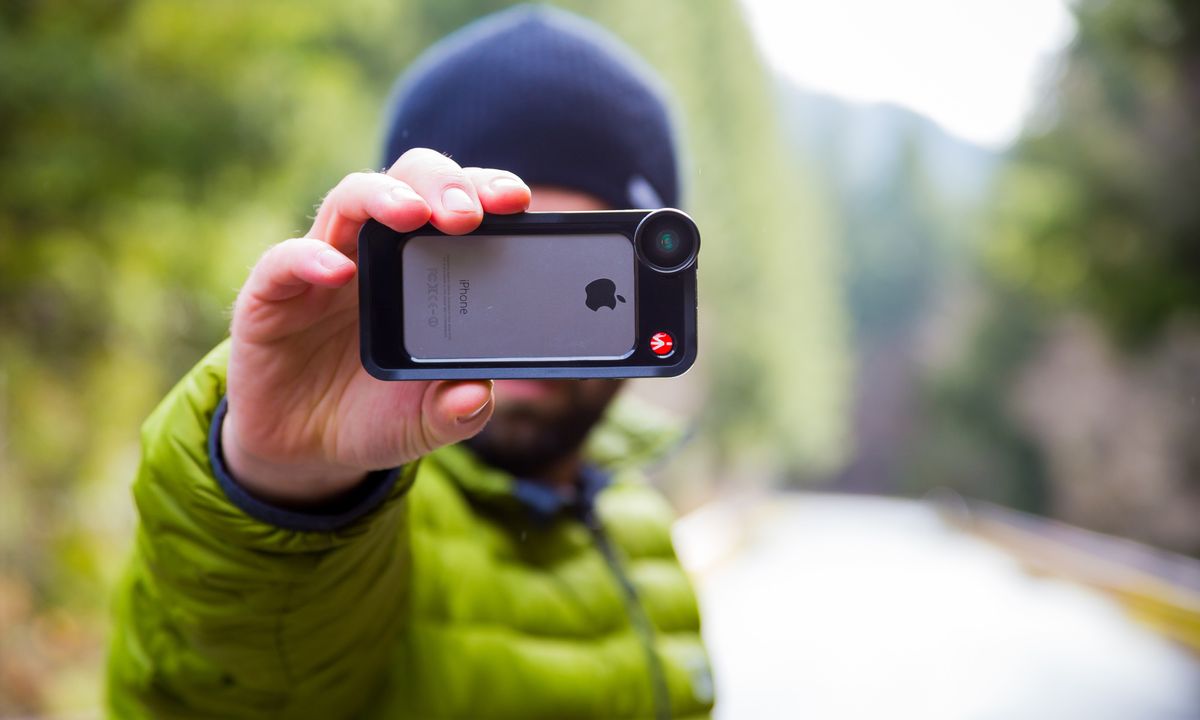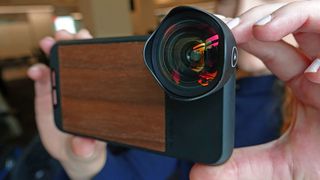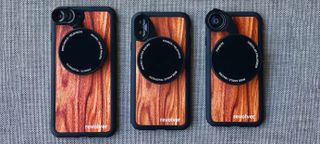The best iPhone lenses can improve the photographic skills of even the latest and greatest Apple smartphones.
While iPhones are among the best phones around, with the iPhone 15 already possessing stellar photographic abilities and the iPhone 14 not far behind it, neither have a dedicated macro or fisheye lens. And yes, the latest iPhone models have a Cinematic Mode — but an Anamorphic lens can provide an even more film-like look. Want to go long with your shots? The iPhone 15 Pro and iPhone 15 Pro Max both have a 3x telephoto lens, but one of the best iPhone lens kits could increase their range further.
Whichever iOS device you own, the best iPhone lenses can improve your photography, getting you some way towards matching the prowess of the best cameras. Some are designed for specific models, but others will work with multiple phones, including popular Android devices — albeit sometimes with an adapter.
So read on for our pick of the best iPhone lens kits and give your mobile some new photographic skills.
The best iPhone lenses you can buy today
While expensive — each of its lenses costs between $80 to $130 — we think that Moment makes the best iPhone lens kits overall. Based on our tests with competing premium iPhone lens kits, the images from Moment’s lenses are some of the best we’ve seen from any smartphone camera lens attachment.
Moment makes a lens for just about every occasion: telephoto, wide angle, macro, anamorphic, and fisheye. And, the company makes cases for a wide range of smartphones, including the latest iPhone 14 range. Cases come in a variety of colors and finishes, and also include slim models and ones with extra batteries.
In addition, Moment also sells a range of filters, including neutral density and circular polarizers; while they don’t work in conjunction with its lens kits, you can use the filters with your smartphone’s camera.
Read our full Moment iPhone lens review.
After testing several models, the Moment anamorphic lens came out on top as the best iPhone lens for filmmakers. It can be oriented so you can hold your phone in either landscape or portrait mode, and, because it’s locked in place, can’t easily be jarred out of place. And, it helps you take some excellent video.
However, the Moment Anamorphic lens is a little more expensive than the competitors: It sells for $149 but also requires that you purchase a case, which adds between $30 and $40 to the cost. That said, a current sale brings it down to $99 direct from Moment.
Sandmarc’s Anamorphic lens ($129.99) is a good alternative, if you can find it for sale.
After testing a number of inexpensive options, the best iPhone lens kit for those on a budget is the Xenvo Pro 2-in-1 system. The Xenvo 2-in-1 combination lens combines a Super Wide lens and a 15X Macro lens, and attaches to your camera using a universal clip, which can be used on any number of smartphones.
The lens is encased in a relatively nice aluminum housing, and comes in a little semi-hard case with a round, rechargeable clip-on light with three different brightness settings. Both lenses are decently sharp in the middle of the photo, however get softer towards the edges. Taking a photo of a patterned chair revealed the threads of fabric looping together in each color.
While the Xenvo produces acceptable images, it’s no match for the more expensive lens systems that we have reviewed from Moment or Sandmarc. During our testing, we found that if the phone is not held still, the amount of detail in the photo was certainly lacking. Still, for $45, it is not a very risky investment if you are just getting into iPhoneography and want a better wide angle and macro lens combo.
If you own an older iPhone model then the Ztylus M6 Revolver is worth a look, because it includes a case for the iPhone X down to iPhone 7. In the middle of the case is a disc that the M6’s lenses attach to magnetically. The actual lenses, six in all, are contained in a circular puck, about 1.5 inches in diameter. Depending on the size of your hands, it may get in the way of getting a secure grip on the phone, since it takes up a good portion of the back of the case.
Images taken using the M6 Revolver’s telephoto lens were good, and because it was magnetically attached to the case, made it much less susceptible to bumping or misalignment than traditional clip-on lenses.
In addition to the telephoto lens, the M6 has a second telephoto, a wide angle, macro, super macro, and fisheye lens. And, because all are contained in the puck, they’re much easier to carry around than clip-on lenses, and stay protected when not in use.
The M6 Revolver is available with one of up to 15 different cases, from a simple wood grain or carbon fiber to colorful patterns and Asian-inspired designs with dragons to quirky designs with cats and fish. Quality is certainly not the same as more expensive lenses from Moment or Sandmarc, but should be good enough for most people.
How to choose the best iPhone lens for you
For the most part, smartphones lens accessories do an admirable job of allowing you to shoot photos that mimic some of the qualities you’ll find in high-end cameras that accept interchangeable lenses. But it’s important to remember, the expensive lenses you’d use with an SLR or mirrorless camera are pricey for a reason. In other words, you’ll want to dial back your expectations when buying even one of the best iPhone lens kits.
Here are four things to remember about most smartphone lens accessories, and where they come up short in comparison to high-end cameras.
At best, image quality remains the same: Since these lenses, in almost all cases, are attached by placing them over the rear-facing lens on your phone, the quality, at best, remains the same. In other words, the sensor and lenses combo isn’t improved. In some cases, with say a telephoto lens, the sharpness in the center may display modest improvement; however, it’s in the corners of the photo where sharpness really needs to be tested. With these lenses, the sharpness almost always falls dramatically in the corners. Even the best iPhone lens kits will also usually introduce a host of other problems, such as distortion, chromatic aberration (producing conspicuous purple outlines around subjects), and light falloff (where the center is much brighter than the images at the edges of a photo). Most high-quality interchangeable lenses made for DSLRs and mirrorless cameras are designed to significantly limit distortion, aberrations, and other optical defects.
Telephoto lenses produce worse images and video than wide angle: No matter which telephoto lens you attach to your phone, it will produce blurrier photos and more jittery video footage than any wide angle or fisheye. That’s because telephoto lenses are highly susceptible to handshake and vibration, and many smartphones, particularly older models, lack effective image stabilization. Our advice would be to get a tripod if you plan on shooting with a telephoto lens.
Lower quality flash photos: Some smartphone lenses block a smartphone’s flash, which further limits your ability to capture decent photos in low light. This is rarely an issue with an interchangeable-lens camera.
Awkward designs and other limitations: Since these lenses need to fit snugly over your smartphone’s lens, you’ll need to remove the camera’s case, or be forced to use a case that’s only compatible with the lens. Additionally, once you attach the lens, it prominently sticks out from the phone, ruining its sleek design. Good luck slipping that into your back pocket! Lastly, these lenses lack the sophisticated apertures and other hardware you’ll find on interchangeable lenses, which allow you to produce truly professional-looking images. Even the best iPhone lens kits can’t compete with ‘proper’ camera lenses on this front.
How we test iPhone lenses
When we test iPhone lenses, the first thing that we naturally look at is how well they perform. Cheaper lenses — those made from plastic, for example — will cause the photos you take to have blemishes, such as chromatic aberrations (purple fringes around objects) and blurriness. This is most evident with fisheye and wide-angle lenses, where objects towards the edges will be much blurrier than those towards the center.
We also evaluate iPhone lenses in terms of ease of use: how easy are they to attach and remove from your smartphone? If it takes longer than a second, you could miss that shot you wanted to get. We also look at the price, as not everyone has $100 to spend just on a single lens; often, you can find models that cost less, but deliver nearly the same quality. Lenses also get bonus points if they work with more than just iPhones; why can’t Android owners have some fun, too? With all of those criteria considered, we’re able to compile our list of the best iPhone lens kits.
If you’re looking to beef up your other smartphone photography kit, you’ll want to check out our guide on the best ring lights, for perfectly exposed selfies and vlogginc content every time. You’ll also want to make sure you invest in one of the best iPhone tripods, to make sure you’re shooting from a steady platform. Why take photos and leave them unedited? Our guides to the best photo editing apps and best photo editing software will help you decide on the right editing software for you. And bear in mind that whether you’re using one of the best camera phones or best cheap cameras, you’ll need lots of storage space for your photos. Don’t worry, we’ve got you covered there too with our guide to the best photo storage sites.
Thinking of upgrading from your smartphone camera? Make sure you read our pick of the best cameras to help you decide which is right for you. If you already know which side you’re taking in the DSLR vs. mirrorless debate, check out our guide to either the best mirrorless cameras or best DSLR cameras.









